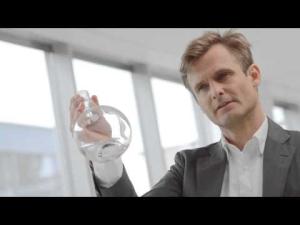Peter Holme Jensen, Claus Hélix-Nielsen and Danielle Keller
Energy-efficient water purification
Winners of the European Inventor Award 2014 in the category SMEs
The invention utilises the natural movement of water between individual cells in nature and the characteristics of the proteins facilitating this movement. The proteins, called aquaporins, allow for water to transfer between cell membranes, all the while blocking the passage of contaminants such as salts and minerals. The inventors incorporated this principle into a “biomembrane” technology.
Conventional water filtration methods channel contaminated water through a series of increasingly fine-pored filters at intense pressures; a highly energy-consuming process, further complicated by the potential of pores becoming clogged. Without the need for external and energy-intensive hydrostatic pressure, the invention uses the process of “forward osmosis” for transporting water molecules through a membrane featuring aquaporins integrated in a backing layer.
Societal benefit
An estimated 1.5 billion people worldwide have no access to clean drinking water. At the same time, industrial demand not just for clean but specifically ultrapure water (UPW) is steadily increasing. The Aquaporin filters are already providing an energy-efficient method for purifying water into UPW for industrial uses. In the next step, the technology can be applied to large-scale purification plants to desalinate seawater and purify industrial wastewater – a considerable contribution to global drinking water supplies.
Economic benefit
The Aquaporin membrane not only produces pure water – it produces ultrapure water for the semiconductor and photovoltaic industries, where even the tiniest particles could damage components in the nanometre range.
The global water purification market is currently estimated at EUR 271 billion, with an annual growth rate of 4-5%. A market share of 21-22%, or EUR 58 billion, is generated by the sale of equipment, technology and treatment chemicals; also including water treatment technology like Aquaporin’s biomembrane filters. In 2011, Aquaporin A/S partnered up with German company Membrana GmbH, one of the leading providers of microporous membranes for medical use worldwide, with the aim of integrating the Aquaporin technology.
How it works
Biomimetic membranes such as the ones invented by Jensen and team mimic the natural water-channelling properties of aquaporin proteins by incorporating them in an active layer over a highly porous teflon support. The narrow folds or pores of the membranes use osmosis to allow pure water to pass through. Although the water molecules can only pass in “single file”, progress is extremely swift, with rates measured at one billion molecules per channel per second.
The inventor
Did you know?
Media gallery
Contact
European Inventor Award and Young Inventors Prize queries:
european-inventor@epo.org Subscribe to the European Inventor Award newsletterMedia-related queries:
Contact our Press team#InventorAward #YoungInventors











